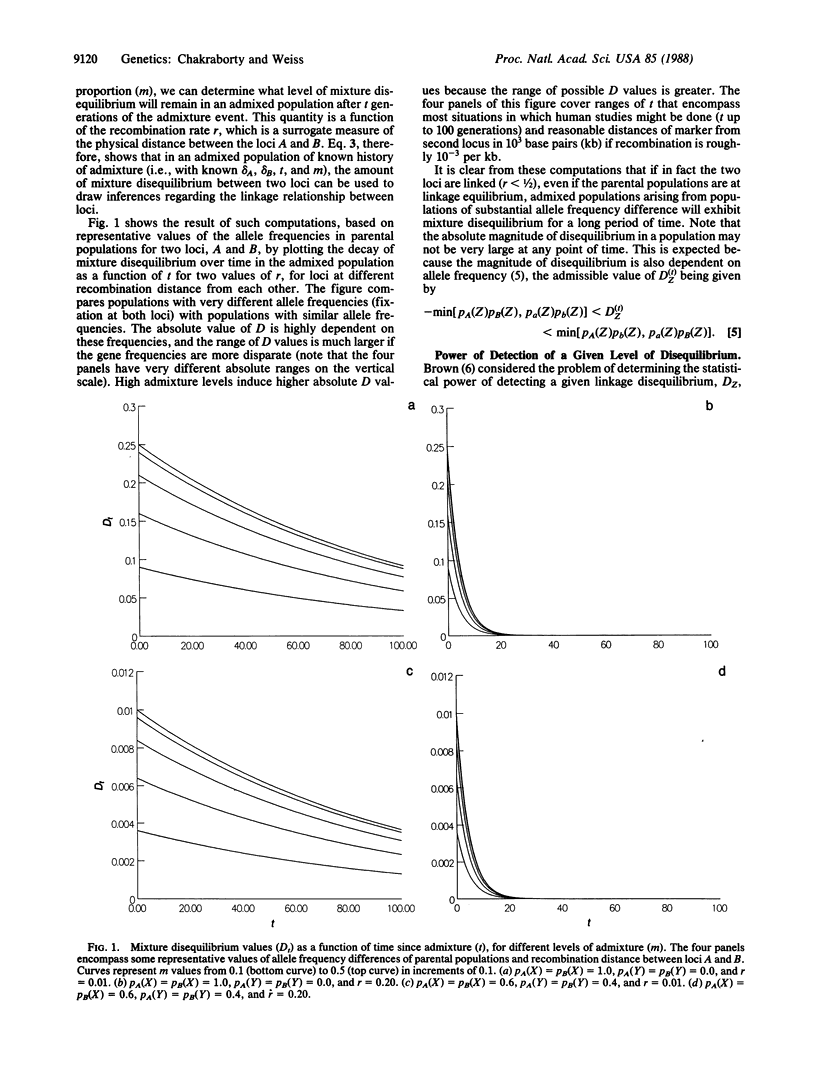Abstract
Admixture between genetically different populations may produce gametic association between gene loci as a function of the genetic difference between parental populations and the admixture rate. This association decays as a function of time since admixture and the recombination rate between the loci. Admixture between genetically long-separated human populations has been frequent in the centuries since the age of exploration and colonization, resulting in numerous hybrid descendant populations today, as in the Americas. This represents a natural experiment for genetic epidemiology and anthropology, in which to use polymorphic marker loci (e.g., restriction fragment length polymorphisms) and disequilibrium to infer a genetic basis for traits of interest. In this paper we show that substantial disequilibrium remains today under widely applicable situations, which can be detected without requiring inordinately close linkage between trait and marker loci. Very disparate parental allele frequencies produce large disequilibrium, but the sample size needed to detect such levels of disequilibrium can be large due to the skewed haplotype frequency distribution in the admixed population. Such situations, however, provide power to differentiate between disequilibrium due just to population mixing from that due to physical linkage of loci--i.e., to help map the genetic locus of the trait. A gradient of admixture levels between the same parental populations may be used to test genetic models by relating admixture to disequilibrium levels.
Full text
PDF




Selected References
These references are in PubMed. This may not be the complete list of references from this article.
- Brown A. H. Sample sizes required to detect linkage disequilibrium between two or three loci. Theor Popul Biol. 1975 Oct;8(2):184–201. doi: 10.1016/0040-5809(75)90031-3. [DOI] [PubMed] [Google Scholar]
- Chakraborty R. Detection of nonrandom association of alleles from the distribution of the number of heterozygous loci in a sample. Genetics. 1984 Nov;108(3):719–731. doi: 10.1093/genetics/108.3.719. [DOI] [PMC free article] [PubMed] [Google Scholar]
- Chakraborty R., Ferrell R. E., Stern M. P., Haffner S. M., Hazuda H. P., Rosenthal M. Relationship of prevalence of non-insulin-dependent diabetes mellitus to Amerindian admixture in the Mexican Americans of San Antonio, Texas. Genet Epidemiol. 1986;3(6):435–454. doi: 10.1002/gepi.1370030608. [DOI] [PubMed] [Google Scholar]
- Chakraborty R., Smouse P. E. Recombination of haplotypes leads to biased estimates of admixture proportions in human populations. Proc Natl Acad Sci U S A. 1988 May;85(9):3071–3074. doi: 10.1073/pnas.85.9.3071. [DOI] [PMC free article] [PubMed] [Google Scholar]
- Chakraborty R., Weiss K. M. Frequencies of complex diseases in hybrid populations. Am J Phys Anthropol. 1986 Aug;70(4):489–503. doi: 10.1002/ajpa.1330700408. [DOI] [PubMed] [Google Scholar]
- Hanis C. L., Chakraborty R., Ferrell R. E., Schull W. J. Individual admixture estimates: disease associations and individual risk of diabetes and gallbladder disease among Mexican-Americans in Starr County, Texas. Am J Phys Anthropol. 1986 Aug;70(4):433–441. doi: 10.1002/ajpa.1330700404. [DOI] [PubMed] [Google Scholar]
- Lewontin R C. The Interaction of Selection and Linkage. I. General Considerations; Heterotic Models. Genetics. 1964 Jan;49(1):49–67. doi: 10.1093/genetics/49.1.49. [DOI] [PMC free article] [PubMed] [Google Scholar]
- Nei M., Li W. H. Linkage disequilibrium in subdivided populations. Genetics. 1973 Sep;75(1):213–219. doi: 10.1093/genetics/75.1.213. [DOI] [PMC free article] [PubMed] [Google Scholar]
- Thomson G., Klitz W. Disequilibrium pattern analysis. I. Theory. Genetics. 1987 Aug;116(4):623–632. doi: 10.1093/genetics/116.4.623. [DOI] [PMC free article] [PubMed] [Google Scholar]


